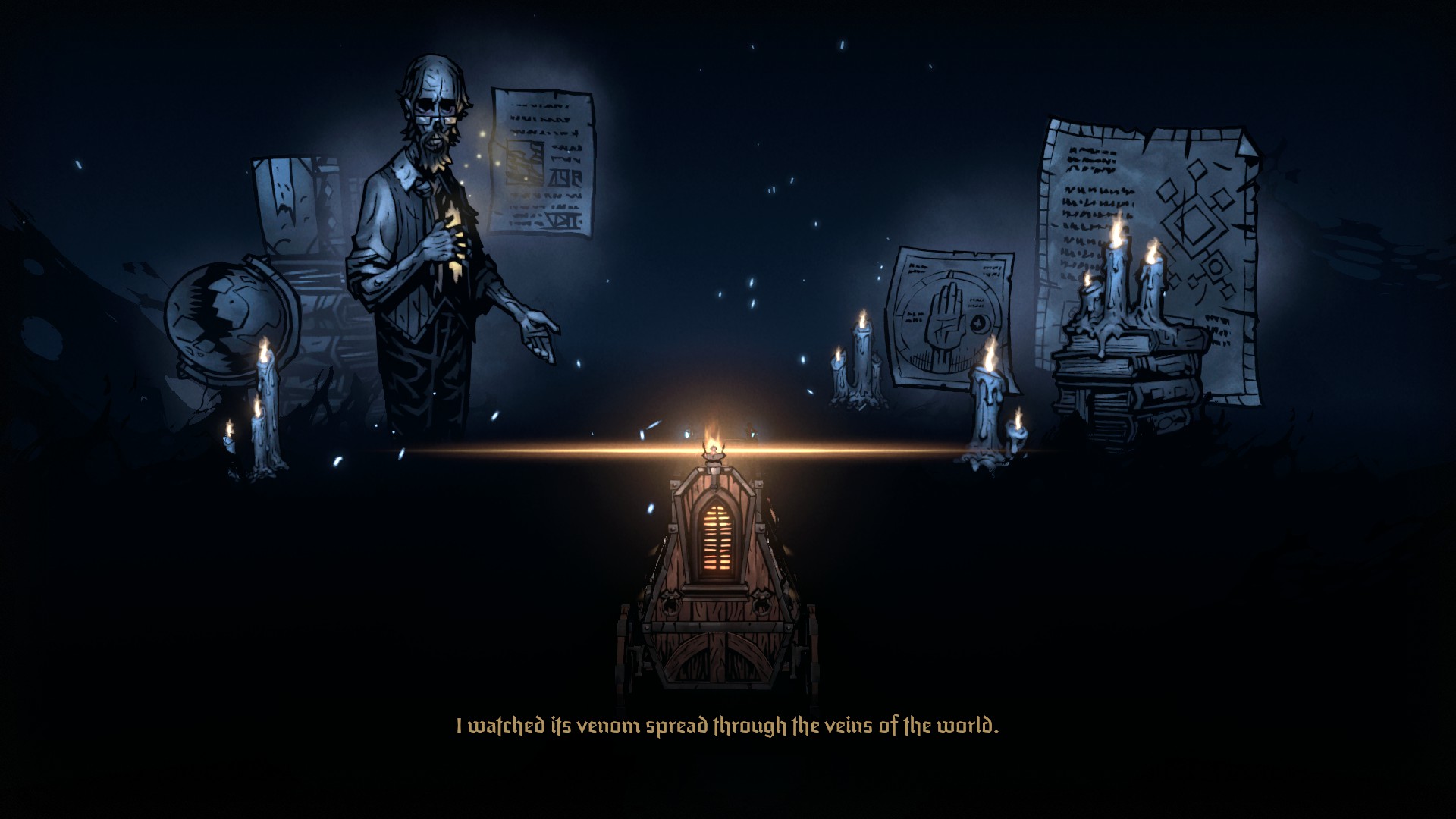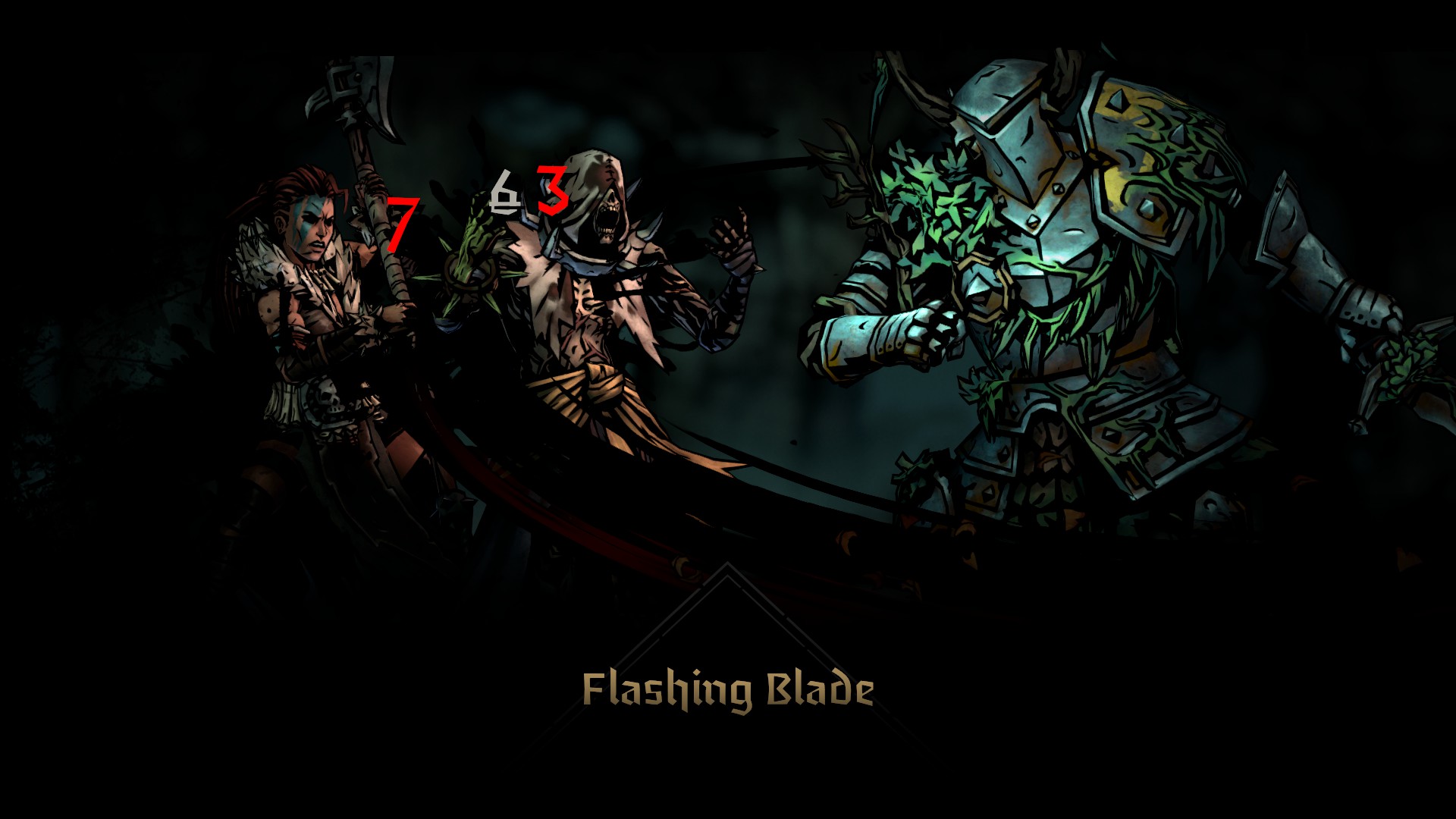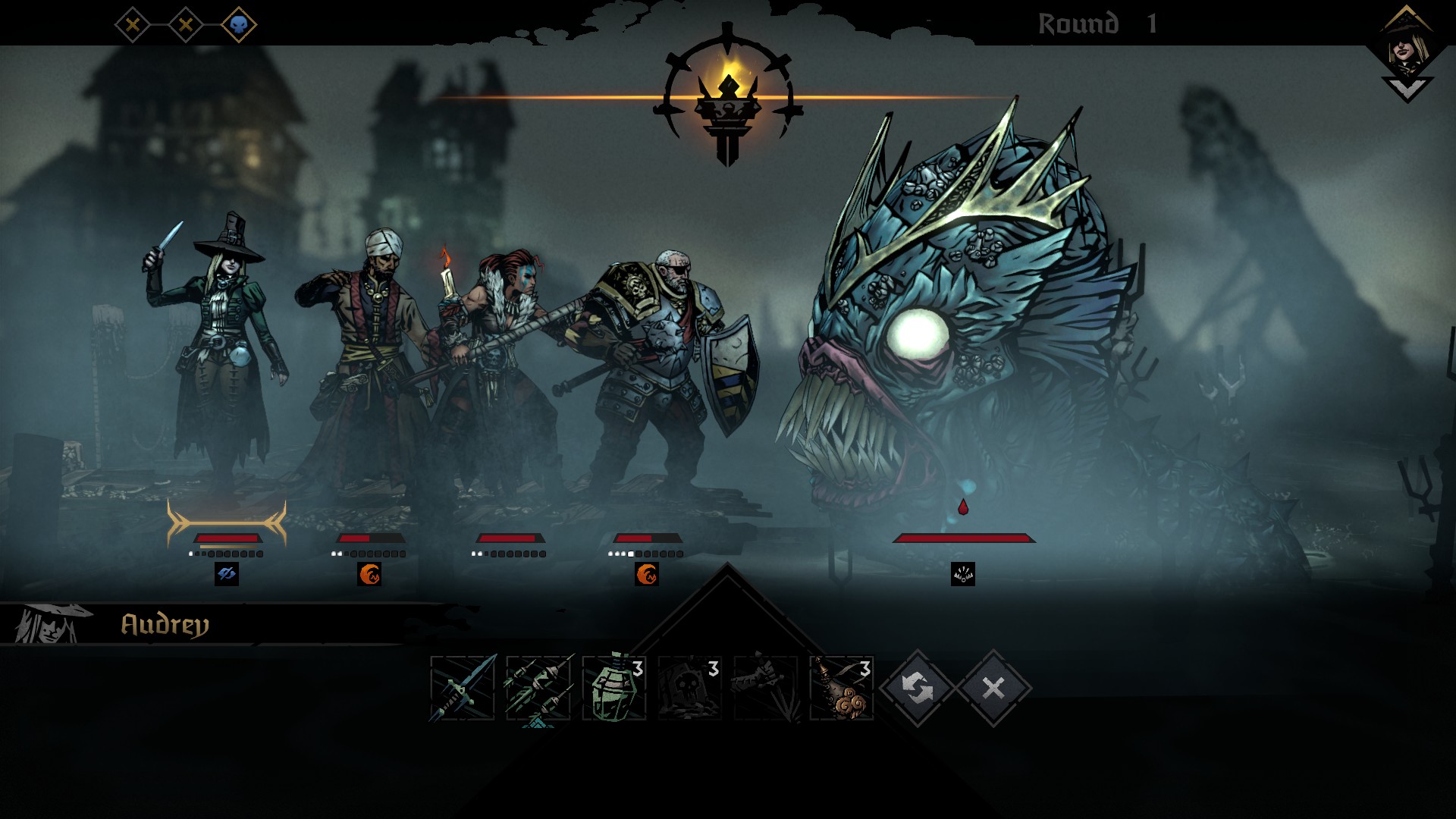Darkest Dungeon 2 – Misty Mountain
Not many dungeons, but a whole lot of darkness
Darkest Dungeon 2 makes some big changes from the original, but keeps the brutal combat.
Darkest Dungeon was an absolute belter of a game. An interesting world, exciting turn-based combat with perma-death, and an art style that’s as grimy as it is memorable were brought together to make a genuinely brilliant, albeit very challenging, game. The much anticipated sequel has been in early access for a year or so, and now that it’s out in the wild I’ve been eagerly playing away at a game that wildly changes some of the original’s systems but keeps a core of brutal gameplay.
So first, a quick primer on the previous game. You would lead a band of adventurers into a variety of dungeons around your family’s estate, trying to find the cause of the maladies harming the surrounding environment. You’d explore, find helpful items, and fight the twisted denizens of the underground. Between excursions you would use resources you’d acquired to rebuild the nearby hamlet, with taverns, shops, and medical facilities to outfit, enhance, and frequently replace your heroes. It was challenging, and at times a slog, as losing a high-level hero would require you to build a replacement up to the same level which could take some time. Still, the dungeon-crawling gameplay was very enjoyable.

With a similar story, Darkest Dungeon 2 does away with a lot of this, favouring a rogue-lite approach to the meta-level of the game, whilst keeping the turn-based four-on-four combat. You no longer have a village to manage, or heroes to level up and replace. Now, you select your four heroes and travel along a road in a caravan, choosing which directions to take based on what events you want to take on in a node system that you might recognise from the likes of Slay the Spire. You’ll take on enemies, heal warriors, and collect items along each route, before eventually arriving at an inn to recover and prepare for the next stage of your excursion. After you’ve been through a set number of areas, assuming you survive, you’ll enter the mountain to take on the final boss of that chapter. Should you fail along the way, you’ll be sent back to the start with any collected candles, which can be used to buy permanent upgrades to characters, as well as items, and cosmetics.
This will be quite a shift for a lot of players of the original who were expecting, or even wanting more of the same. I actually liked this change, as it really increases the pace of the game, and doesn’t force you to grind characters back up after a bad run. You can complete a chapter, of which there are five, in about an hour and a half, but you’ll certainly fail more than a few times. The loss of the hamlet management aspect is a bit disappointing, but again, I’d rather be managing my heroes than building a sanatorium.
Combat works in the same way as it did before, with your four heroes taking on up to four enemies. Position in your party matters, as certain attacks can only be used if you are on the front line, whilst others require a character to be in a different spot. Buffs, debuffs, and damage over time abilities are often key to victory, and Darkest Dungeon 2 has these in spades. Too many, I would argue, as I kept on having to refer to the reference guide to check what each symbol meant. After a while, they become fairly recognisable, but it’s initially irritating.

Much like before, you need to manage health as well as stress. Maxing out stress leads to your character either being resolute, where they gain health and buffs, or having a meltdown, and dropping to near-zero health. This is a bit of a loss, as previously there were lots of different possible meltdowns, with a variety of results. I suppose the benefit here is you know what you’re getting when it comes to that, so you can at least prepare. Having a balanced party is therefore key, with you needing to have a tank to take the hits, a damage dealer or two, and a healer and/or stress healer. This means your initial party choice is actually more limited than you might think, especially considering you can only take one of each class rather than multiple instances like you could before.
To replace those different meltdowns, you now have character relationships. Your party members have a track that follows how much they like other members, and depending on how high or low it is, they may develop a positive or negative relationship with that character. This means that using certain abilities in battle will positively or negatively affect their partner. I liked this system to a point, as it can be very powerful, but it does mean that you may be locked into equipping certain abilities that you may not want or having one of your abilities become near unusable due to the debuff attached to it.
Characters gain abilities by visiting hero shrines along certain routes. These are unlocked for all future runs, which is nice, and come with a little back story about the character. The Jester and Graverobber now come across as actual people with a past rather than just a class with a name attached like before. I really enjoyed this and liked the occasional puzzle/combat sections that would come with them.

Finally, there are the bosses, and these are great. The scale of them is often amazing, and they all have their own unique mechanics you’ll need to figure out. Be prepared to fail the first time you take one on, as they often hit hard and can mess with your party’s abilities. Smaller ones will appear on some of the nodes on the map, based on the region you’re in. These are certainly neat, with the likes of the Leviathan and the Sleeping General being highlights. You’ll need to take these on to be allowed access to the mountain to take on the chapter boss, and these are the real centrepieces of the experience. They take a lot of effort and planning to take down thanks to their powerful attacks that can quickly take down your party if you’re not careful. Beating them is hugely satisfying, and rewards you with a load of candles, as well as access to the next chapter.
After my initial uncertainty over the change in direction, I found myself really liking the gameplay of Darkest Dungeon 2. The changes actually streamline the experience a lot. If you find your chosen party is a poor combination, you can abandon the run and try again with no penalty beyond the short time you were using them, and the lack of a levelling system eliminates the grind almost entirely. Randomness, though, can be an issue.
There are a lot of chance elements at play here. Using candles to unlock items gives you a random one. Your attacks can hit and miss based on chance if you have a debuff. What’s on that path you’re sending your caravan down? No idea as there are just question marks. Will the boss make a massive attack twice in a row? I hope not. You can mitigate a lot of this, with scouting abilities showing you what’s on the different routes, and items that can improve accuracy, but at times you do feel beholden to the dice gods, which is a little frustrating when you’ve had an otherwise amazing run. This somewhat comes with the territory with a rogue-lite though, and it’s not like the previous game gave you perfect information at all times either.

Wayne June is back as the narrator, which is wonderful thanks to that gravelly voice that fits the Lovecraftian, macabre tone perfectly. Big, meaty-sounding attacks make a comeback too. I especially like the crack of the Highwayman’s pistol as he takes down another foe. The music too, is really fitting, and creates just the sort of ambience you want, although you’ll likely hear the same pieces a lot. The visual style is strikingly different to what has come before. The muted, grimy colour palette is still there, but characters are now 3D models and are considerably bigger. This adds to the weight of attacks as they come swinging in and makes each combat encounter feel much more claustrophobic.
For me, there’s been a lot of high praise here! But then come the bugs. Remembering that this has had a year in early access to get to this full release, there sure are a lot of bugs that I’ve encountered. The occasional visual glitch isn’t all that concerning, but more significant ones are. I had ones that made the game easier, such as character goals rewarding me with candles before I did anything, or me starting a run with huge amounts of resources for no reason. Then there are more problematic ones, such as the one I came across where an enemy would constantly cast healing spells over and over, stuck in a loop, meaning I would have to abandon a run. This kept happening to the point that I had to start the whole game from scratch, which was quite galling after five hours. There’s also the odd case of my graphics settings resetting every time I launch the game, along with framerate drops in the most bizarre of places. These aren’t isolated to me either, as I’ve seen a lot of talk on the Steam forums about them.
Thankfully, developers Red Hook seem to be trying to keep on top of this, with regular patches to squash bugs and balance the game further. Ignoring the bugs, I’ve really enjoyed Darkest Dungeon 2. It’s snappier than the original, whilst maintaining some of the best elements of the original. The inclusion of items that can modify the difficulty of the game rather than relying on difficulty settings is nice, making this arguably more accessible too. I’ll be diving back in for more adventures soon.

Darkest Dungeon 2 is available now on PC.
Comments are closed.